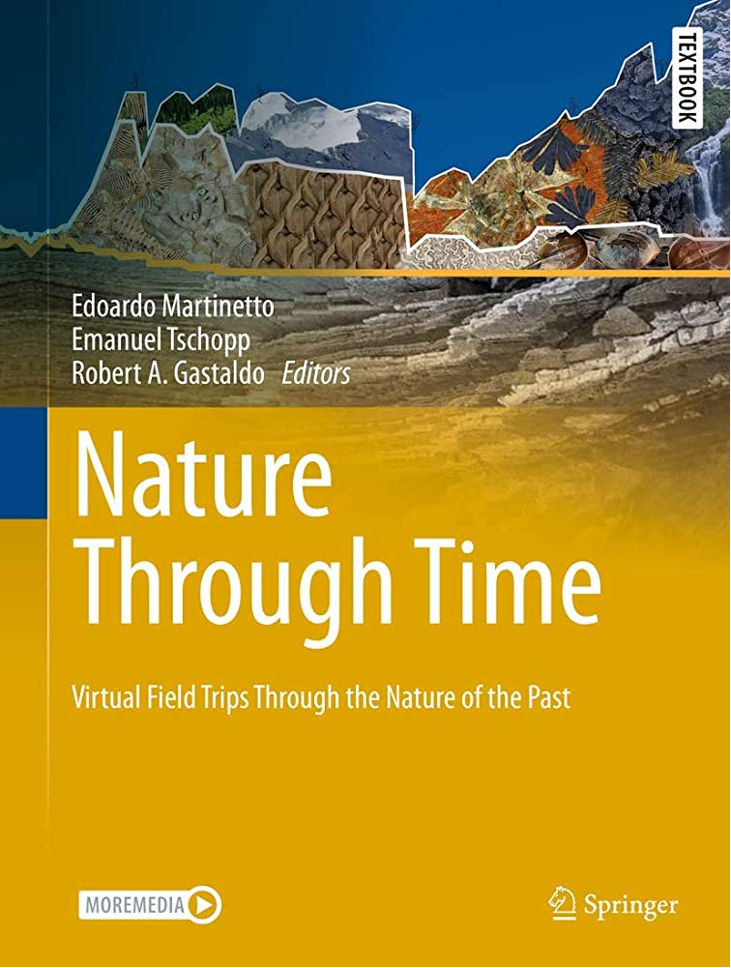Reviewed by Bruce Rothschild (Indiana University Health, formerly Carnegie Museum of Natural History)

Martinetto, E., E. Tschopp and R. A. Gastaldo, eds. 2020. Nature Through Time: Virtual Field Trips Through the Nature of the Past. Springer Textbooks in Earth Sciences, Geography and Environment. Springer, Switzerland. 462 pp plus multimedia. ($16.99 ebook, $16.99 paper, $69.99 cloth).
Avoiding the “‘dry,’ impersonal ‘scientific’ style” and specialty-specific terms and jargon is identified as the goal in the authors’ efforts at combining the efforts of an international consortium of 100-plus scientists to produce a “tour guide” to the past. They succeeded, producing an encyclopedic work that is very readable, which provides a great balance of verbiage with impressive, inspiring imagery and offers the opportunity for access to supplemental slides. They provide a worldwide geographic and chronologic view of occurrence and change, predicated on in-depth presentation of topology-related individual areas through time, followed by a general synthesis not only of the “what,” but also the “why.” They additionally delineate questions that focus readers’ attention to the important issues and to utilization of multi-disciplinary sources to understanding organismal variation through time. This text thus provides a “feel” for the times, as if one were participating in field trips through multiple sites through time and across geography. It presents a balanced presentation of controversial issues (e.g., explaining diversity and extinctions). The authors distinguish established, “widely accepted” concepts and those that continue to be debated.
Confusion related to climate-related terms is addressed in text and glossary, along with an astrophysical explanation, with “boxes” and illustrations providing clarity. Terminology is clarified, distinguishing extirpation from extinction. The editors did a masterful job supplementing information missing from a given chapter with its provision in other chapters in which it was more pertinent, thus limiting duplication. This is exemplified by chapter 15 (“Back to the beginnings”) and its presentation of the evolution of plant structures, which supplies the necessary background for chapters 11, 12 and 13.
The first chapter (“The last three millions of unequal spring thaws”) addresses climatic phases and effects on stable oxygen isotopes, geography, and the effect of glaciation and floral and faunal diversity, extirpations and extinctions, and interactions of tectonic event-related geomorphology determining resultant flora. Noting the absence of modern analogues, chapter 1 coordinated the findings from many disparate specialties, also including that derived from archeology.
Chapter 2 ( “Triumph and fall of the wet, warm and never-more-diverse temperate forests [Oligocene-Pliocene]”) is the only one that deviated from the general pattern of the book. It is truly more encyclopedic than “touring,” as it is densely packed with facts about temporal forests and their historical development. Chapter 3 (“Aridity, cooling, open vegetation, and the evolution of plants and animals during the Cenozoic”) tours the history of open habitats and the grasses they engendered.
Chapter 4 (“The Paleocene-Eocene thermal maximum”) reviews plants as proxies for temperatures, precipitation, and atmospheric concentrations of carbon dioxide and biome specificity, even when taxonomic leaf identification is not possible, based partially on stomatal characteristics and density. This included addressing sources and reservoirs for carbon dioxide release during the Pliocene-Eocene thermal maximum. Chapter 5 (“When and why nature gained angiosperms”) suggests that the angiosperms may have initially emulated weeds and addresses reproductive mechanisms (e.g., seed dormancy) that led to their success. Chapter 6 (“Postcards from the Mesozoic: Forest landscapes with giant flowering trees, enigmatic seed ferns, and other naked-seed plants”) provides insight to their development, the role of their digestibility, and especially the apparent role of nutrient-extraction time in sauropod evolution.
Chapter 7 (“Dinosaurs, but not only: Vertebrate evolution in the Mesozoic”) explores sauropod energy-saving strategies, physiology, and their use of geothermal heat to incubate their eggs. It includes discussion of anatomic alterations related to ornithischian quadrupedality, separation of what became ear ossicles as part of an adaptation for food mastication, dental modifications for mammalian suckling and dermal modifications (e.g., whisker formation), which increased environmental awareness. While no book can cover everything and Mesozoic reptiles may well deserve a text of their own, the discussion of non-dinosaurian reptiles was limited. Inclusion of hypotheses as to the timing of fish evolution and an introduction to paleohealth would have been welcomed, but the latter is admittedly my bias. Chapter 8 ( “How to live with dinosaurs: ecosystems across the Mesozoic”) examined dinosaurian diversity through time.
Chapter 9 (“Early Mesozoic nature in and around Tethys”) related climate change to Mesozoic volcanic activity, exploring the relationship between the geologic environment and biomes. Chapter 10 (“The end-Permian mass extinction: Nature’s revolution”) addressed what happened, noting global ecosystem timing, scale, the responsible combination of environmental changes and that pattern of recovery crisis that pushed life close to complete annihilation 252 million years ago.
Additional chapters move into the Paleozoic, with chapters focused on ferns, the Late Paleozoic coal forests in the context of icehouse-hothouse climates, Silurian-Devonian trilobites, and the earliest plant communities.
The taxonomic index is especially useful, directing attention to figure and box locations in individual chapters and to the availability of slides useful for teaching. The inserted (in the text) reference access component, at least in the electronic version, is very convenient. All in all, a valuable tour guide to the geologic past.

